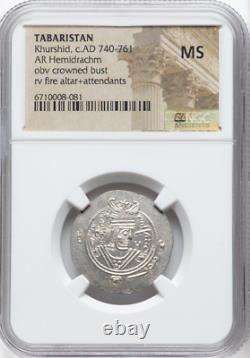NGC MS Tabaristan Khurshid (r. 740-761 AD) Silver Hemidrachm Fire Altar Coin




Time of the Umayyad - Abbasid Caliphates. Khurshid, governor of Tabaristan r. 740-761 AD AR (Silver) hemidrachm.
Certified MS by NGC; boldly struck on radiant surfaces. Design: Sassanid-style imperial bust resembling Khusrow II, r. 590-628 AD right / Zoroastrian fire-altar flanked by two attendants.
Dimensions: 26 mm / 2.00 gm. Historical Background: After the Arab Muslims swept out of the Arabian Peninsula in the mid-seventh century, they conquered much of the the eastern territories of the Byzantine Empire (Egypt, Syria) and the entire Sassanid Empire further to the east. However, certain areas previously under Sassanid dominion remained resistant to their new overlords.One of these regions was Tabaristan, a remote, sparsely populated area on the southern shores of the Caspian Sea. The local governors struck coins for many decades (all the way until about 800 AD) that were virtually identical to the pre-Islamic, Sassanid silver coinage. The obverse of these Tabaristan issues feature the typical Sassanid royal portraiture. Even more boldly, especially when one considers the new Islamic rulers' stance on non-Abrahamic religions, the reverse shows a fire-temple of the ancient Zoroastrian religion.
This coin was struck by the governor Khurshid, who ruled at a time of great tumult and upheaval in the Muslim world. The ninety-year old Umayyad dynasty, which had grown the Arab realm to stretch from Spain to India, was overthrown by an internal revolt led by the Abbasid family in 749-750. The Abbasids moved the capital from Damascus to Baghdad, inaugurating a golden age of Islamic higher learning, particularly in the fields of science, medicine, mathematics, and poetry.
Please feel free to reach out with any questions!
